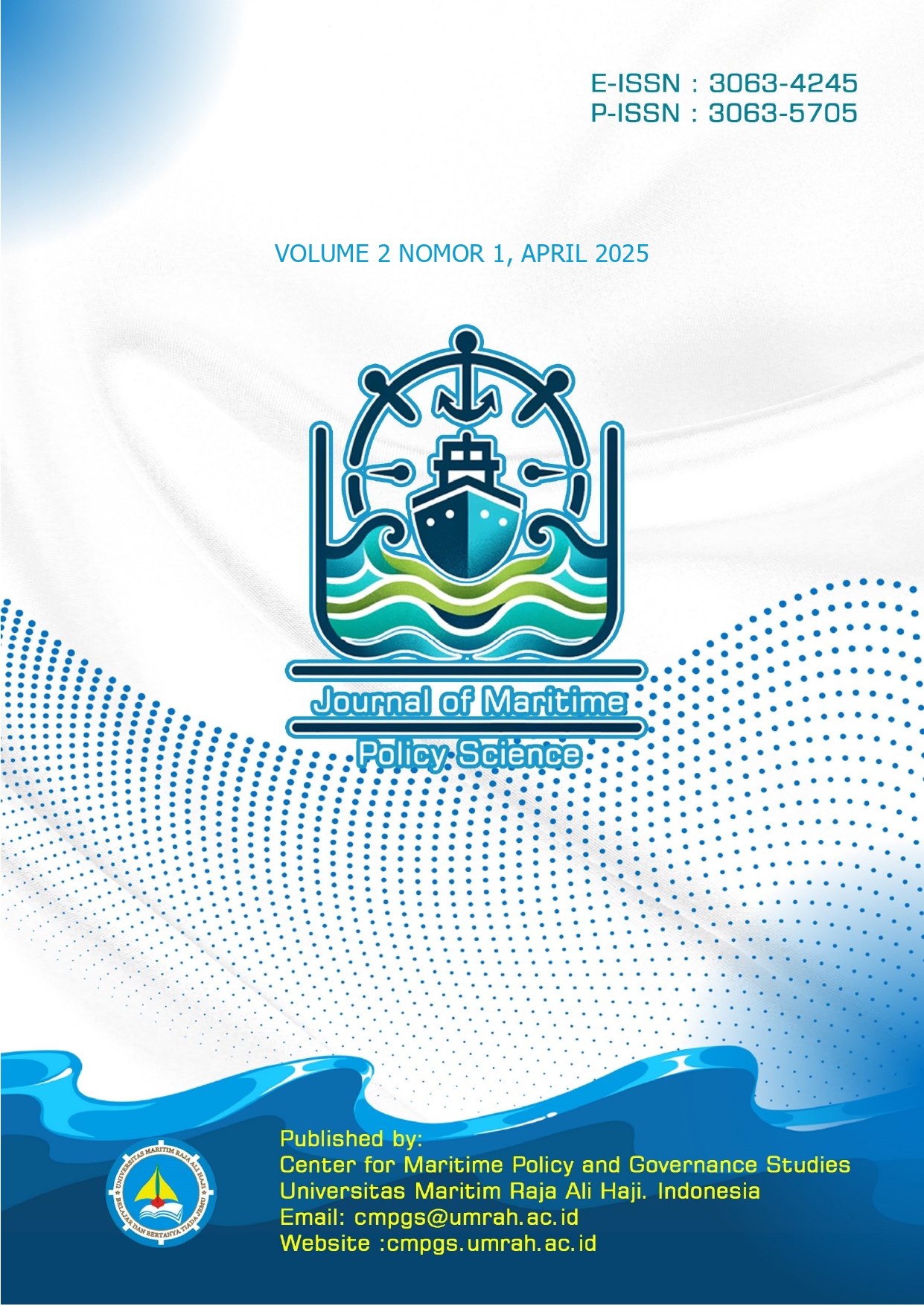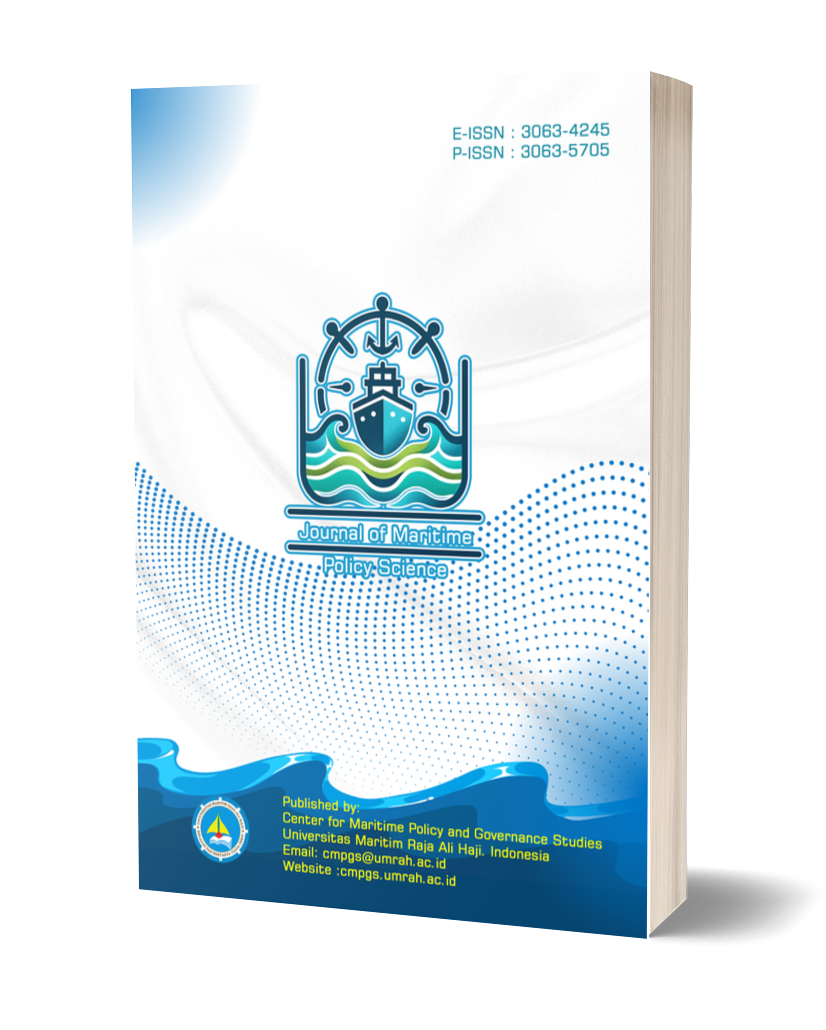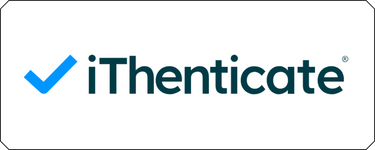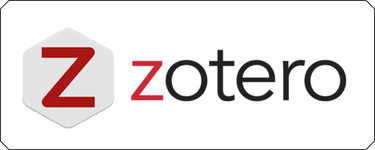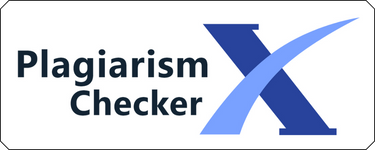Regional Policy Diversification to Maximize Blue Economy Potential in Kepulauan Riau Amid Indonesia-China Bilateral Cooperation
DOI:
https://doi.org/10.31629/jmps.v2i1.7165Keywords:
Diversification, Blue Economy, Bilateral, Economic Growth, Local GovernmentAbstract
Indonesia’s ambition to enhance its maritime economy has been reinforced by its bilateral cooperation with China through the Memorandum of Understanding (MoU) on Deepening Blue Economy Cooperation. This initiative presents a significant opportunity for maritime provinces like Kepulauan Riau, which possess vast marine resources yet remain underutilized. Despite having 96% of its territory covered by sea, the region's fisheries sector contributes only 1.72% to its Gross Regional Domestic Product (GRDP), revealing a substantial gap between potential and economic realization. This study aims to explore how regional policy diversification can optimize blue economy potential in Kepulauan Riau amid growing bilateral cooperation. A qualitative descriptive-analytical approach was employed, using secondary data from official statistics, government regulations, academic literature, and blue economy policy frameworks. The study identifies tourism, fisheries, renewable energy, maritime transport, and climate mitigation as key sectors for development. The findings suggest that integrating these sectors through tailored regional policies aligned with local characteristics can create a synergistic effect, amplifying the benefits of blue economy investments. Additionally, strategic policy alignment with national blue economy roadmaps and the inclusion of local stakeholders are crucial to ensure equitable and sustainable outcomes. In conclusion, the research highlights that regional diversification, guided by the principles of sustainability, inclusivity, and local relevance, is essential to transforming external cooperation into real and balanced economic growth for Kepulauan Riau. Such a strategy ensures that no community is left behind in the national pursuit of blue economy advancement.
Downloads
References
Arbar, T. (2024). Sah! RI-China Teken Kerja Sama Blue Economy, Ini Manfaatnya. CNBC Indonesia. https://www.cnbcindonesia.com/market/20241110104342-17-587026/sah-ri-china-teken-kerja-sama-blue-economy-ini-manfaatnya
Ayilu, R. K., Fabinyi, M., & Barclay, K. (2022). Small-scale fisheries in the blue economy: Review of scholarly papers and multilateral documents. Ocean Coast Manag, 216, 105982.
Douvere, F., & Ehler, C. N. (2011). The importance of monitoring and evaluation in adaptive maritime spatial planning. Journal of Coastal Conservation, 15(2), 305–311. https://doi.org/10.1007/S11852-010-0100-9
Febriani, R. (2023). Riau, Kepri dan Sumbar Berpotensi Mendukung Penurunan Emisi GRK - Riau Pos. RiauPos.Co. https://riaupos.jawapos.com/pekanbaru/2253591498/riau-kepri-dan-sumbar-berpotensi-mendukung-penurunan-emisi-grk
Germond, B. (2015). Maritime Security and Safety — Securing, Policing, and Protecting the Seas. The Maritime Dimension of European Security, 73–89. https://doi.org/10.1057/9781137017819_6
Khairunnisa, K., Tetty, T., Hafsar, K., Haidawati, H., Wahyudin, W., Suhana, M. P., Muzammil, W., Putra, R. D., & Hanifah, H. (2021). The Recovery Strategy of Mangrove Tourism after Covid-19 Pandemic in Bintan Island, Indonesia. E3S Web of Conferences, 324. https://doi.org/10.1051/E3SCONF/202132404001
Kusumawardhani, R. T. (2023). Peluang dan Tantangan Blue Economy Indonesia. Buletin APBN, 77(1), 3–6. www.puskajianggaran.dpr.go.id
Lamidi, L. (2024). Galang Batang SEZ: Advancing the Blue Economy through Strategic Development. Journal of Maritime Policy Science, 1(2), 60–69. https://doi.org/10.31629/JMPS.V1I2.6940
Lapointe, D. (2020). Reconnecting tourism after COVID-19: the paradox of alterity in tourism areas. Tourism Geographies, 22(3), 633–638. https://doi.org/10.1080/14616688.2020.1762115
Mahadiansar, M., Alfiandri, A., & Marliani, M. (2023). PESTEL Analysis of Blue Economy Development Policy in Indonesia. BIO Web of Conferences, 70, 05005. https://doi.org/10.1051/BIOCONF/20237005005
Mahadiansar, M., Alfiandri, A., & Syuzairi, M. (2023). Analysis of Collaborative Governance in Tourism Based on Coastal Community Empowerment in Indonesia. Proceedings of the International Conference Social - Humanities in Maritime and Border Area, 5–10. https://doi.org/10.2991/978-2-38476-150-0_2
Manullang, A. J. (2024). Unraveling the Maintenance of Southeast Asia’s Maritime Security: A Look into the ASEAN Maritime Outlook. Journal of Maritime Policy Science, 1(1), 40–48. https://doi.org/10.31629/JMPS.V1I1.6878
Margaretha, R., Syuzairi, M., & Mahadiansar, M. (2024). Digital Transformation in the Maritime Industry; Opportunities and Challenges for Indonesia. Journal of Maritime Policy Science, 1(1), 1–10. https://doi.org/10.31629/JMPS.V1I1.6872
Marliani, M. (2024). Enhancing Maritime Security: Challenges and Strategies in Indonesia’s Natuna Sea. Journal of Maritime Policy Science, 1(1), 32–39. https://doi.org/10.31629/JMPS.V1I1.6876
Muzwardi, A., & Mahadiansar, M. (2024). Stakeholder Analysis of Indonesia’s Trade the Regional Comprehensive Economic Partnership (RCEP) Actor Non-ASEAN. Journal of Maritime Policy Science, 1(2), 82–92. https://doi.org/10.31629/JMPS.V1I2.6942
Patton, M. Q. (2002). Qualitative research and evaluation methods. In Qualitative Inquiry (Vol. 3rd). SAGE. https://doi.org/10.2307/330063
Prescott, J. R. V. ., & Schofield, C. H. . (2005). The maritime political boundaries of the world . BRILL.
Pushp, P., & Ahmed, F. (2023). The global value chain: Challenges faced by ASEAN least developed countries. Journal of Policy Modeling, 45(6), 1223–1245. https://doi.org/10.1016/j.jpolmod.2023.06.001
Ridwanuddin, P. (2022). Siaran Pers Ekstraksi Ekonomi Biru Mendorong Perampasan Ruang Laut. In WALHI. https://www.walhi.or.id/siaran-pers-ekstraksi-ekonomi-biru-mendorong-perampasan-ruang-laut
Smith-Godfrey, S. (2016). Defining the Blue Economy. Maritime Affairs: Journal of the National Maritime Foundation of India, 12(1), 58–64.
Sovacool, B. K. (2010). A critical stakeholder analysis of the Trans-ASEAN Gas Pipeline (TAGP) Network. Land Use Policy, 27(3), 788–797. https://doi.org/10.1016/j.landusepol.2009.10.012
Tirumala, R. D., & Tiwari, P. (2022). Innovative financing mechanism for blue economy projects. Mar Policy, 139, 104194.
van Hoof, L., & van Tatenhove, J. (2009). EU marine policy on the move: The tension between fisheries and maritime policy. Marine Policy, 33(4), 726–732. https://doi.org/10.1016/j.marpol.2009.02.007
Voyer, M., Schofield, C., Azmi, K., Warner, R., McIlgorm, A., & Quirk, G. (2018). Maritime security and the Blue Economy: intersections and interdependencies in the Indian Ocean. Journal of the Indian Ocean Region, 14(1), 28–48.
Xu, L., Huang, J., & Chen, J. (2023). How does the initiative of 21st century maritime silk road incentive logistics development in China’s coastal region? Ocean and Coastal Management, 239. https://doi.org/10.1016/j.ocecoaman.2023.106606
Downloads
Published
Issue
Section
License
Copyright (c) 2025 Fery Andana, Cantius Fransisco Wisnu Bayu Saputra (Author)

This work is licensed under a Creative Commons Attribution-ShareAlike 4.0 International License.
You are free to:
- Share — copy and redistribute the material in any medium or format for any purpose, even commercially.
- Adapt — remix, transform, and build upon the material for any purpose, even commercially.
- The licensor cannot revoke these freedoms as long as you follow the license terms.
Under the following terms:
- Attribution — You must give appropriate credit, provide a link to the license, and indicate if changes were made . You may do so in any reasonable manner, but not in any way that suggests the licensor endorses you or your use.
- ShareAlike — If you remix, transform, or build upon the material, you must distribute your contributions under the same license as the original.
- No additional restrictions — You may not apply legal terms or technological measures that legally restrict others from doing anything the license permits.

